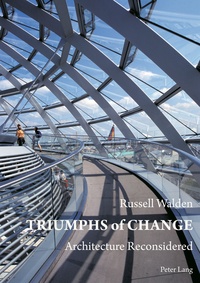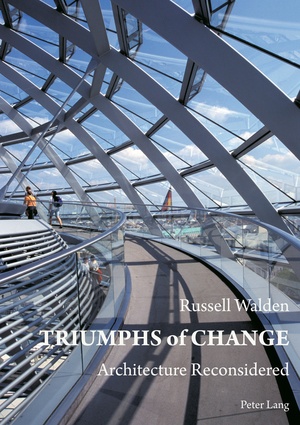Triumphs of change: Architecture Reconsidered
Professor Michael J. Ostwald, Dean of Architecture at the University of Newcastle in New South Wales, Australia, reviews 'Triumphs of Change: Architecture Reconsidered' by Dr Russell Walden from Victoria University of Wellington's School of Architecture:
In 1947, in the midst of the rebuilding process after the second world war, the German academic Rudolf Wittkower began to write Architectural Principles in the Age of Humanism. While this famous book was ostensibly an explanation of the architecture of Palladio – including a discussion of his use of harmonic musical ratios – the book also contained a veiled critique of the mass-produced, over-scaled and mediocre architecture of modernity. Although Wittkower never displayed a deep understanding of the tectonics or craft of architecture he did correctly sense that much of what was being built at that time would not embrace basic human needs or inspire people to higher thoughts or deeds.

Dr Russell Walden’s ground-breaking Triumphs of Change shares some of the concerns and aspirations of Wittkower’s work. Both scholars feel passionately about the power of architecture and are concerned with the general malaise that so often besets architecture when it is produced too quickly and without due consideration of the needs of the community. However, there are also two key differences between the works of Wittkower and Walden; perspective and motive. Wittkower was writing from the perspective of an art historian and the catalyst for his work was the inhumanity of the rebuilding effort. Walden is a scholar with a detailed appreciation of the practical and material concerns of architecture and his motivation is more closely concerned with the loss of democracy, humanity and wonder in much recent, developer-driven, architecture.
Instead of re-treading the tried-and-true paths taken by scholars through the terrain of architectural history, Walden sets out to chart a new course that rejects the simplistic categorisation of architecture in stylistic terms and proposes a new set of guiding principles. The first of these three principles, sense, refers to the “tangible craft of good building”; it is as much about making sensible decisions as it is about a broad skill-base.
The second, sagacity, is concerned with “the intelligent application of sense” in a specific design or to serve a particular client brief. These first two principles return the criticism or appreciation of architecture to issues or materiality, structure, construction and purpose. The third and final principle, sublimity, is a partial departure from this trend, and at first glance it seems to conform to the poetic, formal and tectonic ideals of Ruskin, le Duc, Kahn and Le Corbusier and, to a certain extent, this is true. For Walden, the sublime is necessarily intangible, but it is not imaginary. The sublime encompasses the architectural expression of a range of external influences including the economic, the social and the political. But it is the nuanced and considered response to these influences, expressed through sense and sagacity, that creates great architecture.
With these new colours nailed firmly to the mast, Walden sets out to rethink a series of canonical buildings from the point of view of their client’s needs, the technology and materials of their era. The buildings include temples and monasteries, a theatre, a church, an airport and a gallery, among many others. They span from antiquity to the present day and from small domestic structures to major urban buildings. One of Walden’s great achievements is that across this breadth of history and the range of projects, he is able to consistently reinforce the practical and material nature of design decisions, and then tie them to the more transcendent, spiritual and poetic qualities of these great buildings.
There are several themes that recur throughout the work. The first, and probably the most important, is concerned with the human social condition. Walden reminds us that the democratic ideal was predicated on the desire to improve the world for all people. Indeed the spirit of Athena, Greek goddess of wisdom, balance and democracy, permeates much of the work, from the early discussion of Greek temples to the later analysis of public space. The second major theme is concerned with composition, and Walden reinforces several famous connections between architecture and music and constructs some new ones. From Wright to Beethoven, Calatrava to Mozart and Aalto to Sibelius, a strong parallel is drawn between compositional and phenomenal qualities in architecture and music.
But let us step away from the content of the book for the moment, and consider its character. Triumphs of Change is international in scope; being largely written in the antipodes, its focus and inclinations are defiantly European. There are references to New Zealand, Australia and Asia, but Walden’s agenda is global and, as such, the examples he cites are those that have the greatest degree of international recognition. Furthermore, the book has a respected European publisher with a reputation for supporting world-class, scholarly works.
One of the buildings singled out for discussion in Triumphs of Change is Hagia Sophia in Istanbul. This great building has inspired many architects and scholars throughout the years. One of the most famous was Sinan; the most revered architect of the Ottoman era. In the 16th century Sinan famously said that, for a revered architect or a scholar, their life should be marked by at least three major works. The first represents the break from “apprenticeship”, the second he described as the act of surpassing conventional “qualifications” and the last was a demonstration of supreme “mastery”. From Walden’s previous works, The Open Hand (1977), Voices of Silence (1988) and Finnish Harvest (1998) to Triumphs of Change, he has clearly fulfilled Sinan’s description of mastery. In Triumphs of Change Dr Russell Walden has written a provocative and timely aide-mémoire for architects about the importance of the human condition, but it is also an important reminder about the time it takes for good scholarship to find its way into the world.











